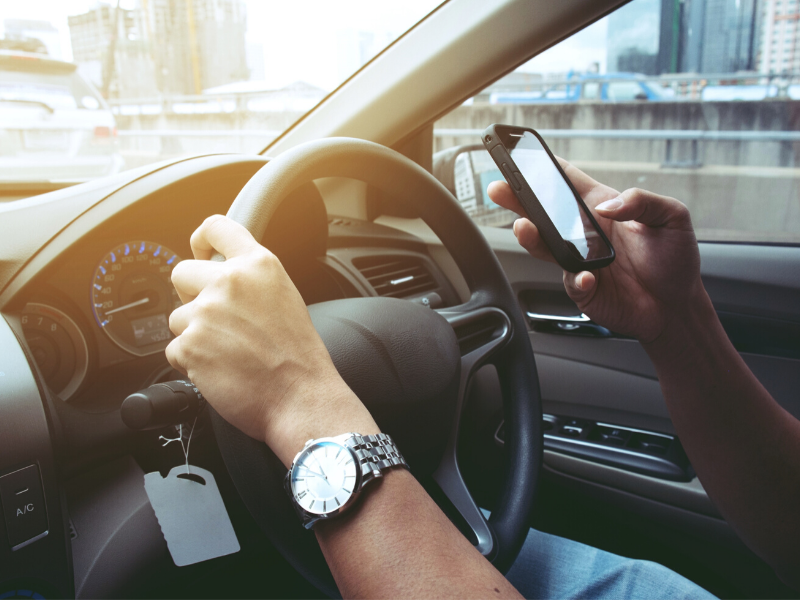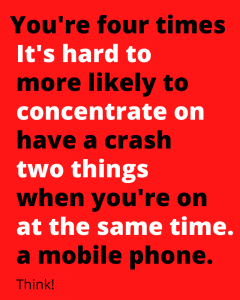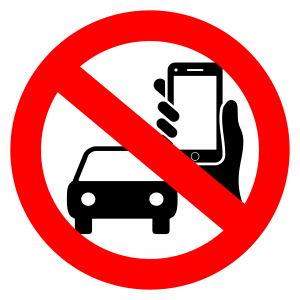25th June 2020
Mobile phone use: a growing problem of driver distraction

As post-lockdown traffic builds, there is a significant danger that many motorists will have come to rely on digital communication in recent months and will be tempted to answer calls, respond to texts or stay connected through their phones even when back behind the wheel.
However, using a hand-held or hands-free mobile phone while driving is a significant distraction that substantially increases the risk of having an accident.
Although using a hand-held phone causes the greatest distraction, using a hands-free phone does not significantly reduce the risk. It still causes distraction because the driver is concentrating on two thinking tasks at the same time and often taking their eyes off the road to look at the screen.

Driving is the most dangerous work activity that most people do and according to RoSPA “over 100 people are killed or seriously injured every week in crashes involving someone who was driving or riding for work.”
Drivers who use a hand-held or a hands-free mobile phone:
- are much less aware of what’s happening on the road around them
- often take their eyes off the road altogether to look at the screen
- fail to see road signs
- fail to maintain proper lane position and steady speed
- are more likely to ‘tailgate’ the vehicle in front
- react more slowly and take longer to brake
- are more likely to enter unsafe gaps in traffic
- feel more stressed and frustrated.
They are also four times more likely to crash, injuring or killing themselves and/or other people.
Mobile phone use: the law
Using a hand-held mobile phone while driving is illegal. It is also illegal if you are a passenger supervising a learner driver.
Mobile phone driving laws were first introduced in December 2003, and from 2007 drivers incurred three penalty points on their licence and a fine (£60 at first, then £100 from 2013).
But from 1 March 2017, the penalty doubled – so being caught using a mobile phone while driving now carries a penalty of six points and a £200 fine.
New drivers who have only passed their test in the past two years will also face losing their licence if they are caught.
Hands-free phone use: the law
You are allowed to use a phone if it is fully hands-free but you are not allowed to pick it up and use it to communicate, even momentarily.
And although not specifically illegal, drivers using a hands-free phone whilst driving could still be charged with ‘failing to have proper control of their vehicle’ with the penalty being a fine of up to £1,000, three penalty points and a discretionary disqualification.
Any hands-free devices should be fully set up before you drive, so you can take calls without handling the device.
When can you use a phone in your vehicle?
The law is clear on when you can use a hand-held device behind the wheel.
It is only legal if you are safely parked – and this does not include waiting in traffic or stationary at the traffic lights.
The law also includes a proviso for emergencies: you are allowed to make 999 calls on a hand-held device while driving, but only if it’s not otherwise safe to stop.

Can I use my phone while driving if I’m not moving?
Contrary to what many drivers seem to think, the law still applies when your vehicle is stopped at lights or in heavy traffic. If your engine is running, your phone should be nowhere near your hands. This is still the case if the engine stops automatically to save fuel (called ‘start-stop technology’).
Motorists involved in an accident caused by using a hand-held device behind the wheel face stiff penalties as well.
For example, the government is considering increasing the penalty for causing death by dangerous or careless driving from 14 years to life imprisonment.
A two-year driving ban is also obligatory.
How to avoid being distracted
The easiest way to not be distracted by using your mobile phone in the car is to switch it off.
Treat the cabin of your car like you do an aircraft, and put your phone into flight-safe mode before you drive.
If you have to stay in touch, make sure your phone is paired up to Bluetooth, so you can still take calls. But place the phone in the glovebox or keep it in your pocket, case or handbag, out of sight, with the sound turned off, so you won’t be distracted by the screen lighting up or message alert sounds.
All drivers need to consider the consequences before picking up a phone. You wouldn’t do it with a police officer watching and you wouldn’t do it on your driving test. The risk doesn’t just disappear when you think there’s no one watching.
Using a phone while driving is irresponsible and puts not only your own safety at risk, but the safety of those who happen to be sharing the road space with you.
By ensuring your focus is 100% on the journey at all times, you will also be giving yourself the best chance of anticipating any hazards and keeping yourself and others safe.